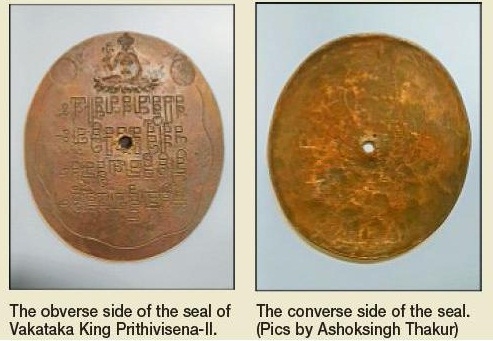Copper seal of Vakataka King Prithivisena-II gets Int’l attention
| Date :14-Mar-2021 |

By Kartik Lokhande :
History keeps making news. Last year, the discovery of a Vakataka-era copper seal at village Gojoli in Gondpipri tehsil of Chandrapur district had made it to headlines. Now, the discovery has gained International attention. A detailed work on the history and significance of the discovery by Amol Bankar and Ashoksingh Thakur has revealed that the copper seal was of Vakataka King Prithivisena-II. Now, the work has featured in the Journal of the Oriental Numismatic Society based in the United Kingdom.
The seal was discovered in village Gojoli in July 2020. The seal was originally brought to light by a local journalist Nilesh Zade, who found it at the house of Ranjit Urade. “On seeing the seal, we were sure that the discovery was very significant. It was the seal of Vakataka King Prithivisena-II. Previously, only the copper-plate grants of the king were known. It was the first time that the seal was discovered,” Ashoksingh Thakur told ‘The Hitavada’. The publication of the finding authored by him and Amol Bankar in the International journal, he said, will add to the knowledge of the public and researchers about Vakataka dynasty that ruled Vidarbha. The seal is made of copper alloy. It is oval in shape. Its weight is 67.42 grams and is 8.5 cm in length, 7.5 cm in width, and 2 mm in thickness.
There is a hole in the centre of the seal indicating that there was once a metal handle to it, to be used for stamping impressions on soft clay or other surfaces/objects. Prithivisena-II (475-495 CE) was the son of Narendrasena and grandson of Pravarasena-II. “Prithivisena was probably the last of Vakataka kings. Nal dynasty king Bhavadattavarman from Bastar ousted Prithivisena-II from his capital and ruled Nandivardhana. So far, four copper-plate grants of Prithivisena-II have been discovered at Mahurjhari, Balaghat, and Mandhal. This is the first time that the seal of his era has been discovered,” Thakur said. “The four-lines of Sanskrit inscription in box-headed Brahmi script are incised on the seal in the negative (mirror image just like rubber stamp). Besides, the royal seal has an image of Vakataka Sri or the personification of wealth and prosperity of the kingdom.
The depiction of the deity Vakataka Sri resembles to a great extent to that of goddess Laxmi on the Gupta-era gold coinage,” Thakur said while describing the inscription on the seal. Amol Bankar translated the inscription on the seal. The inscription was about the seal/order belonging to Prithivisena, the protector of the ‘Sri’ (royal fortune) of Vakatakas. According to Thakur, the royal seal adds to the knowledge of the Vakatakas along with recently discovered terracotta sealing of Pravarasena-II from Kalanjara fort, and a sealing with the name of queen Prabhavati Gupta from Nagardhan excavation in Nagpur district. Department of Archaeology and Museums acquired the Prithivisena-II royal seal. J Wahane, Assistant Director, had sent a letter to Ranjit Urade last year requesting him to gift the copper seal to the Central Museum at Nagpur.
